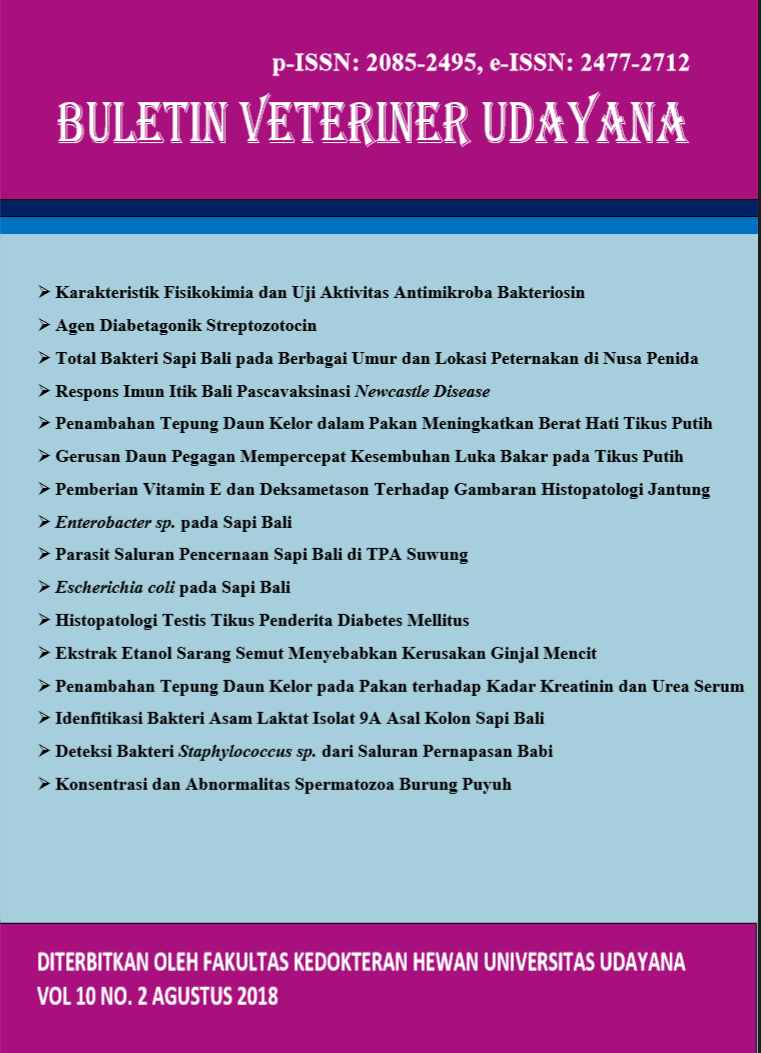ESCHERICHIA COLI ON BALI CATTLE ACCORDING TO MATURITY LEVELS IN DIFFERENT GEOGRAPHICIES AREA AND IT’S PATTERN OF ANTIBIOTICS RESISTANCE
Abstract
A Cross Sectional study to determine the prevalence of Escherichia coli on bali cattle respiratory tractbased on maturity level (calves, heifers, adult) and geographical location (highland and lowland) have been conducted. The isolation and identification of bacteria based on the method of Carter and Cole with slightly modification and antibiotic sensitivity test were performed using the disc diffusion method by Kirby and Bauer. Escherichia coli was isolated from 14 out of the 120 samples (11.66%). Based on the maturity level, was found 7/120 (5.58%), 3/120 (2.50%), and 4/120 (3.33%) from calves, heifers, and adults, respectively. Meanwhile, based on the geographical location, 8/120 (6.66%) E. coli was isolated from the highland and the remains 6/120 (5.00%) from lowland. The antibiograms showed that 6/14 (42.85%), 3/14 (21.42%), and 5/14 (35.71%) of the isolates were resistant, intermediate, and sensitive to sulfamethoxazole, respectively. Whereas 4/14 (28.57%), 1/14 (7.14%), and 9/14 (64.28%) were resistant, intermediate, and sensitive to ampicillin. One isolate (7.14%) was resistant to oxytetracycline and the remains 13/14 (92.85%) were sensitive. Three isolates (21.42%) were sensitive to all tested antibiotics and one isolate (7.14%) resistant to all antibiotics.
Downloads
References
Andrew C, McAllister A. 2016. Antimicrobial Usage and Resistance in Beef Production. J. Anim. Sci. Biotechnol. 7(68): 5-6.
Arcangioli MA, Duet A, Meyer, Dernburg A, Bezille P, Poumarat F, LeGrand D. 2008. The role of Mycoplasma bovis in bovine respiratory disease outbreaks in veal calf feedlots. Vet. J. 177: 89-93.
Ashnagar A, Naseri NG. 2007. Analysis of Three Penicilin Antibiotics (Ampicilin, Amoxicilin and Cloxacilin) of Several Iranian Pharmaceutical Companies by HPLC. e-J. Chem. 4(4): 537.
Bhaskara IBM, Budiasa IK, Tono K. 2012. Uji Kepekaan Escherichia coli Sebagai Penyebab Kolibasilosis Pada Babi Muda Terhadap Antibiotikaa Oksitetrasiklin, Streptomisin, Kanamisin dan Gentamisin. Indon. Med. Vet. 1(2): 186-201.
Carter, G.R., and J.R Cole.1984.Diagnostic Procedures In Veterinary Bacteriology and Mycology. 4th Ed. Academic Press.Inc.
Damayanti E, Sukada IM, Suardana IW. 2015. Faktor Resiko Infeksi Escherichia coli O157:H7 pada Ternak Sapi Bali di Abiansemal, Badung, Bali. Indon. Med. Vet. 4(4): 279-287.
DeRosa DC, Mechor GD, Staats JJ, Chengappa MM and Shyock TR. 2000. Comprasion of Pasteurella sp. Simultaneously Isolated From Nasaal and Trastracheal Swab From Cattle With Clinical Signs of Bovine Respirator Disease. J. Clin. Microbiol. 38: 327-332.
Gabinaitiene A, Siudzdaite J, Zalinskas H, Siugzda R, Petkevficus S. 2011. Mycoplasma bovis and bakterial pathogens in the bovine respirator tract. Vet. Med. 56(1): 28-34.
Gallard JC, Hyatt DR, Crupper SS and Acheson DW. 2001. Prevalence Antibiotic Suscepbility and Diversity of E. coli O157:H7 Isolates From a Longitudinal Study of Beef Cattle Feedlots. J. Appl. Environt. Microbiol. (67): 1619-1627.
Galuh Y, Suarjana IG K, Tono PG K. 2017. Sensitivitas Isolat Escherichia coli Patogen dari Organ Ayam Pedaging Terinfeksi Koliseptikemia Terhadap Oksitetrasiklin, Ampisilin dan Sulfametoksazol. Bul. Vet. Udayana. 9(1): 60-66.
Hartel H, Nikunen S, Neuvonen E, Tanskanen R, Kivela SL, Aho P, Soveri T, Saloniem H. 2004. Viral and Bakterial Phathogens in Bovine Respiratory Disease in Finland. Acta Vet. Scandinavica. (45): 193-200.
Mark AT, Peter MB, David MC, Ronald NJ, Timothy R W. 2007. Global Emergence of Trimethoprim/ Sulfamethoxazole Resistance in Stenotrophomonas maltophila Mediated by Acquisition of sul Genes. Emerg. Infect. Dis. 13(4): 559-565.
Mustika OC, Pinatih KJP, Suardana IW. 2015. Uji Kepekaan Escherichia coli O157:H7 Feses Sapi di Kecamatan Kuta Selatan Badung Bali Terhadap Antibiotika. Indon. Med. Vet. 4(4): 342-350.
Omer A, Berhanu A, Chanie M, Fentahun T. 2012. Isolation and Identification of Aerobic Bacterial from in Nasopharyngeal Passageways of Apparently Healthy and Clinically Sick Sheep at Gondar University Veterinary Clinic. American-Eurasian J. Sci. Res.7(6): 232-237.
Ouchriah Y, Heleili N, Mamache B, Ayachi A, Kassah AL. 2015. Antimicrobial Sensitivity of Bacterial Strains Isolated From Newborn Calves in the Abattoir of Batna (Algeria). Int. J. Livestock Res. 5(2): 32-39.
Pradnya ID A, Besung IN K, Sampurna IP. 2016. Jumlah Non Coliform dan Total Bakteri Pada Sapi Bali di DataranTinggi dan Dataran Rendah di Bali Pasca Pemberian Mineral. Bul. Vet. Udayana. 8(1): 52-58.
Pratiwi, S. 2008. Mikrobiologi Farmasi. Gelora Aksara Pratama. Jakarta.
Reuben R C and Owuna G. 2013. Antimicrobial Resistance Patterns of Escherichia coli O157:H7 From Nigerian Fermented Milk Samples in Nasarawa State, Nigeria. Int. J. Pharm. Sci. Inv. 2(3): 38-44.
Seker E , Kuyucuoglu Y, Konak S. 2009. Bacterial Examinations in the Nasal Cavity of Apparently Healthy and Unhealthy Holstein Cattle. J. Anim. Vet. Adv. 8(11): 2355-2359.
Suardana IW, Juniari P, Besung IN K. 2016. Isolasi dan Identifikasi Escherichia coli O157:H7 pada Feses Sapi di Kecamatan Petang, Kabupaten Badung-Bali. Bul. Vet.Udayana. 8(1): 30-35.
Suminarto B. 2004. Epidemiologi Verocytotoxigenic Esherichia coli (VTEC) Pada Sapi Perah di Jawa Tengah dan Daerah Istimewa Yogyakarta: Kajian Tingkat Ternak. J. Sain. Vet. 22(2): 27-32.





